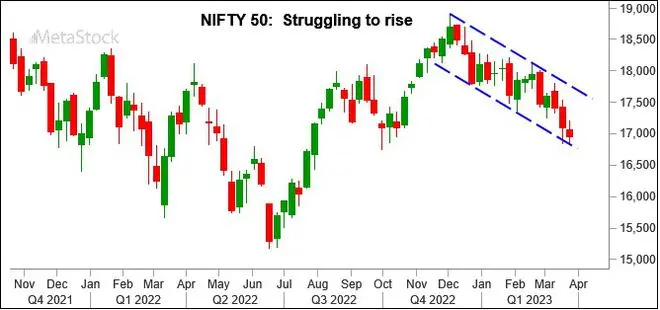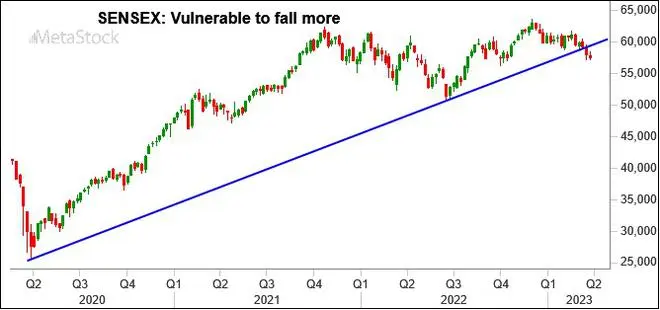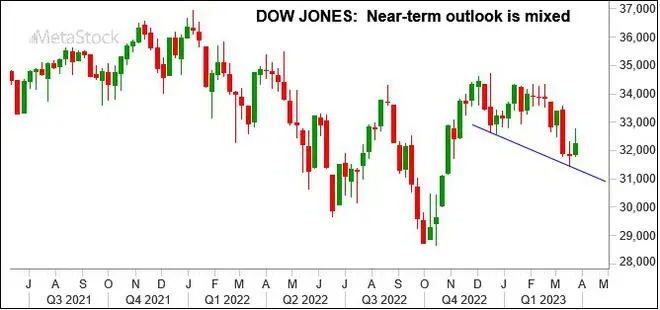High risk aversion in the market is keeping the global equities under pressure. Sensex and Nifty 50 are struggling to rise. The indices were down 0.8 per cent and 0.9 per cent respectively. The price action last week indicates that the benchmark indices lack strong follow-through buyers. This leaves the door open for the Sensex and Nifty to fall more from here. However, such a fall will be a very good buying opportunity from a long-term perspective.
Among the sectors, BSE Power, FMCG and Healthcare indices closed in green. The BSE Power index, up 0.63 per cent, outperformed last week. The BSE Realty and BSE Metal indices fell the most. They were down 4.78 per cent and 4.14 per cent respectively.
FPIs sell
The foreign portfolio investors (FPIs) continued to sell the Indian equities for the second consecutive week. The equity segment saw an outflow of $516 million last week. If the FPIs increase the quantum of selling, it will be negative for the Sensex and Nifty. That can drag the benchmark indices further lower from here. As of now, the equity segment has seen a net inflow of $881.15 million for the month of March.
Nifty 50 (16,945.05)
The resistance at 17,200 held very well last week. Nifty rose to test 17,200 initially, but failed to get a strong follow-through rise. The index made a high of 17,207.25 and has come-off from there. It has closed the week at 16,945.05, down 0.91 per cent.
The week ahead: The near-term outlook is negative. 17,200 will continue to act as a strong resistance. Nifty can fall to 16,800 and even 16,700 this week. A bounce back anywhere from the 16,800-16,700 region can take the index up towards 17,000-17,200 again. In that case, 16,700-17,200 can be the short-term trading range.
A decisive break above 17,200 will be needed to turn the sentiment positive. Only in that case, the short-term outlook will turn bullish to see 17,400-17,600.
On the other hand, if a break below 16,700 is seen, the downside pressure can increase. Such a break can drag the index down to 16,450 and even lower in the coming weeks. To avoid this fall, Nifty has to sustain above 16,700 and break the resistance at 17,200.

Graph Source: MetaStock
Medium-term outlook: As long as the Nifty trades below 17,200, the overall picture is weak. 16,700 is the crucial support to watch. A break below it can take the Nifty down to 16,450 as mentioned above. Such a fall will also keep the door open to test 16,000-15,900 eventually. We can expect the current fall to find a bottom around 16,000 and a fresh rally is possible.
Important resistance to watch is at 17,600. Nifty has to breach this hurdle to bring back the bullishness of seeing 20,000 on the upside.
Nifty Bank (39,395.35)
As expected, the resistance at 40,300 mentioned last week has capped the upside. The Nifty Bank index made a high of 40,201.6 and has come down sharply from there. It has closed at 39,395.35, down 0.51 per cent for the week.
On the weekly chart, last week’s candle reflects indecisiveness in the market. However, on the daily candles, the turn-around from 40,200 indicates that the overall picture is still weak. Strong resistances are at 39,800, 40,100 and 40,300.

Graph Source: MetaStock
Intermediate support is at 39,000. A break below it can drag the Nifty Bank index down to 38,300-38,000 and even 37,500 in the coming weeks. However, important to note is that the 38,000-37,500 is a strong long-term support zone. As such, we expect the current fall to find a bottom anywhere in the 38,000-37,500 region. A strong and fresh rally thereafter may have the potential to break the 41,000-42,000 barrier. Such a break will pave way for a target of 45,000-46,000 over the long term.
So, the fall to 38,000-37,500 is going to be a very good buying opportunity from a long-term perspective.
Sensex (57,527.10)
Sensex rose above 58,000, but failed to sustain higher. It made a high of 58,418.78 and then fell back to close the week at 57,527.10, down 0.8 per cent.
The week ahead: Failure to get a follow-through rise above 58,000 is a negative. This keeps the door open to revisit 57,000 this week. The region between 57,300 and 57,000 is a crucial support zone. If Sensex manages to sustain above 57,000, it can bounce back towards 58,000-58,500. That can keep the index in the 57,000-58,500 range in the near term.
The region between 58,500 and 59,000 is a strong resistance zone. Sensex has to breach 59,000 decisively, to bring back the bullish sentiment. On the other hand, the downside pressure will increase if Sensex breaks below 57,000. In that case, an extended fall to 56,000 is possible.
For now, 57,000-58,500 will be expected trading range. A breakout on either side of this range will give clarity on the next move.

Graph Source: MetaStock
Medium-term view: The overall picture is weak. As mentioned above, 57,000 is a very crucial support. A sustained break below it can increase the selling pressure. Such a break can drag the Sensex down to 55,000 in the coming weeks.
To avoid this fall, Sensex has to sustain above 57,000 and break above 59,000. So, the price action around 57,000 will need very close watch this week.
Dow Jones (32,237.53)
The Dow Jones Industrial Average attempted to breach 32,500, but failed to sustain higher. It made a high of 32,761.89 and has come-off sharply from there. The index has closed at 32,237.53, up 1.18 per cent.
Although the weekly chart looks mixed, the price action on the daily chart is positive. It leaves the chances alive to break 32,500 again and test the resistance at 32,850 this week. However, to gain bullish momentum, the Dow has to break above 32,850 decisively. Only in that case, a rise to 33,500-33,800 will come into the picture.

Graph Source: MetaStock
On the other hand, a reversal from around 32,850 can drag the index down to 32,000 and 31,600. For now, we expect, 31,600-32,850 to be the trading range for this week. As long as the Dow trades below 32,850, the chances of a fall to 31,000 will still remain alive.






Comments
Comments have to be in English, and in full sentences. They cannot be abusive or personal. Please abide by our community guidelines for posting your comments.
We have migrated to a new commenting platform. If you are already a registered user of TheHindu Businessline and logged in, you may continue to engage with our articles. If you do not have an account please register and login to post comments. Users can access their older comments by logging into their accounts on Vuukle.